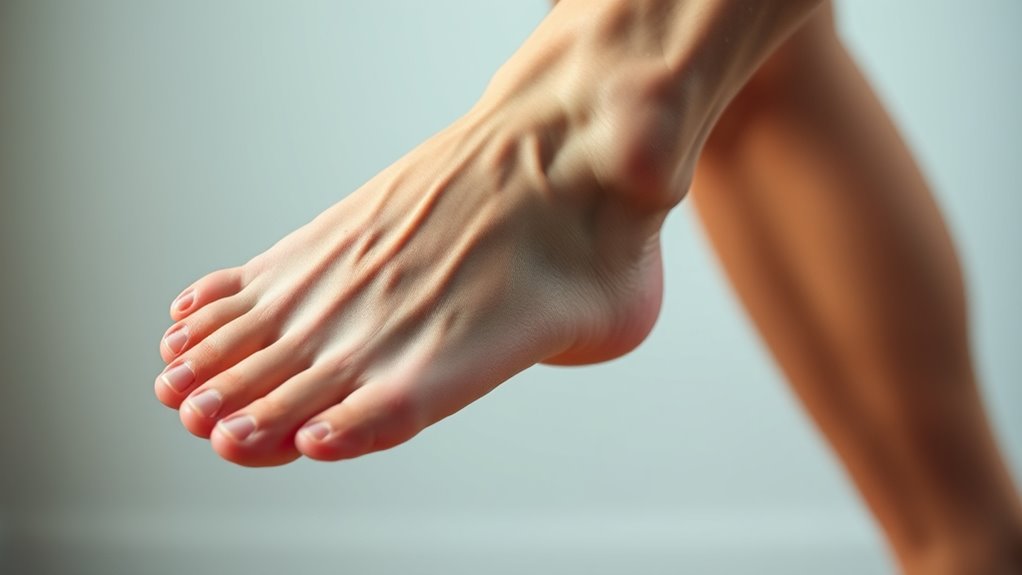Cramping happens when your muscles contract involuntarily due to dehydration, electrolyte imbalances, or muscle fatigue. To prevent cramps, stay well-hydrated with water and electrolyte drinks, and eat foods rich in minerals like potassium, calcium, and magnesium. Proper stretching before and during activity helps keep muscles flexible, reducing tightness. Pay attention to early warning signs and avoid pushing through pain. Keep these tips in mind to help you stay comfortable and active—you’ll find more helpful advice ahead.
Key Takeaways
- Electrolyte imbalances from dehydration or mineral deficiencies can trigger muscle cramps.
- Proper stretching before and during activity helps prevent muscle tightness and spasms.
- Staying well-hydrated with water and electrolyte drinks reduces cramping risk.
- Recognizing early signs of muscle fatigue allows for gentle stretching and adjustment.
- Maintaining a balanced intake of sodium, potassium, calcium, and magnesium supports muscle function.

Cramping can strike suddenly and disrupt your day, often caused by muscle fatigue, dehydration, or mineral imbalances. One common factor behind cramping is an imbalance in your electrolytes, which are essential minerals like sodium, potassium, calcium, and magnesium. These minerals help regulate nerve signals and muscle contractions. When electrolyte levels drop or become unbalanced, your muscles may respond with involuntary contractions or spasms. To prevent this, it’s important to maintain proper electrolyte balance, especially if you’re engaging in intense exercise or sweating heavily. Consuming foods rich in electrolytes, such as bananas, nuts, and dairy, or drinking electrolyte-infused beverages can help keep these minerals at ideal levels.
Electrolyte balance is key to preventing muscle cramps and spasms.
Another key aspect of preventing cramps involves paying attention to muscle stretch. When muscles are overly tight or not properly stretched before physical activity, they become more prone to cramping. A good warm-up session that includes dynamic stretching helps prepare your muscles for the work ahead, reducing the risk of sudden spasms. Similarly, during activity, taking breaks to stretch and gently lengthen your muscles can prevent tightness from setting in. If you notice a muscle starting to stiffen or cramp, gently stretching it can often provide immediate relief. For example, if your calf muscle begins to cramp, pulling your toes toward your shin can help relax the muscle and restore normal function.
Dehydration also plays a vital role in cramping and is often linked to electrolyte imbalance. When you don’t drink enough fluids, your blood volume decreases, and electrolyte concentrations can become too concentrated or too diluted. This disruption can interfere with muscle function, making cramps more likely. Regular hydration, especially during hot weather or vigorous exercise, is essential. Drinking water alongside electrolyte-rich drinks ensures your body maintains the right balance of fluids and minerals needed for ideal muscle performance. Additionally, proper hydration supports overall muscle health and reduces the risk of spasms.
In addition to hydration and stretching, paying attention to your body’s signals during activity is important. If you start feeling tight or notice the early signs of a cramp, slow down and stretch gently. Avoid pushing through pain, as this can deepen the muscle fatigue and increase the likelihood of severe cramping. Incorporating these practices into your routine—balancing electrolytes, stretching properly, staying hydrated—can considerably reduce your chances of experiencing sudden cramps and help you stay comfortable during daily activities or workouts.
Frequently Asked Questions
Can Dehydration Cause Cramps During Sleep?
Yes, dehydration can cause cramps during sleep. When you’re not properly hydrated, your muscles may become more prone to spasms. To prevent this, follow good hydration strategies by drinking enough water throughout the day. Also, maintain sleep hygiene by staying relaxed before bed and stretching gently. These habits help keep your muscles functioning smoothly, reducing the likelihood of cramps waking you up at night.
Are Cramps More Common in Certain Age Groups?
Cramps are more common in older adults, mainly due to age-related muscle changes and hormonal fluctuations that affect muscle function. As you age, your muscles tend to weaken and lose flexibility, increasing cramp risk. Hormonal shifts, especially during menopause, can also contribute to muscle imbalance. Staying active, maintaining proper hydration, and stretching regularly can help reduce your chances of experiencing cramps across all age groups.
How Do Electrolyte Imbalances Contribute to Cramping?
Electrolyte imbalances can cause cramps that feel like your muscles are fighting a battle they can’t win. When your electrolyte balance is off, it disrupts muscle function, making muscles contract involuntarily or spasm wildly. This imbalance affects key minerals like potassium, calcium, and magnesium, which are essential for proper muscle function. To prevent this, stay hydrated and maintain a balanced diet rich in these crucial electrolytes.
Can Specific Medications Increase Cramping Risk?
Yes, certain medications can increase your risk of cramping due to their side effects or drug interactions. Some drugs, like diuretics, deplete electrolytes, leading to muscle cramps. Others may cause dehydration or alter mineral levels, making cramps more likely. Always check medication side effects and consult your doctor about potential risks. Staying well-hydrated and maintaining balanced electrolytes can help reduce your chances of experiencing cramps related to these medications.
What Are the Long-Term Effects of Frequent Muscle Cramps?
Frequent muscle cramps can lead to ongoing discomfort and muscle fatigue, subtly affecting your daily activity. Over time, these cramps may signal underlying nutritional deficiencies or persistent strain, which could weaken your muscles’ resilience. If ignored, this cycle might cause long-term issues like reduced strength or flexibility. Staying attentive to your body’s signals and maintaining proper nutrition can help prevent these potential effects, keeping your muscles healthier and more resilient.
Conclusion
Understanding the subtle signals your body sends can help you navigate moments of discomfort more smoothly. By staying hydrated, stretching regularly, and listening to your body’s quiet whispers, you can often prevent those unwelcome surprises. Remember, gentle care and mindful habits are your allies in maintaining comfort and ease. With a little attention and patience, you’ll find yourself better prepared to enjoy your day—free from unwelcome interruptions—embracing each moment with confidence.









